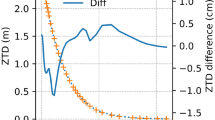Abstract
The Gaussian distribution is a good approximation for transient (instantaneously released) puff concentration distributions within a short period of time after release. Artificial neural network (ANN) models for puff dispersion coefficients were developed, based on observations from field experiments covering a wide range of meteorological conditions (in March, May, August and November). Their average predictions were in very good agreement with measurements, having high correlation coefficients (r > 0.99). A non-linear multi-variable regression model for dispersion coefficients was also developed, under the assumption that puff dispersion coefficients increase with time, and follow power laws. Both ANN-based and multi-regression non-linear models were able to use easily measured atmospheric parameters directly, without the necessity of predefining the Pasquill stability category. Predictions of ANN-based and multi-regression-based Gaussian puff models were compared with those of Gaussian puff models using Slade’s dispersion coefficients and COMBIC, a sophisticated model based on Gaussian distributions. Predictions from our two new models showed better agreement with concentration measurements than the other Gaussian puff models, by having a much higher fraction within a factor of two of measured values, and lower normalized mean square errors.
Similar content being viewed by others
References
Allen CT, Young GS, Haupt SE (2007) Improving pollutant source characterization by better estimating wind direction with a genetic algorithm. Atmos Environ 41: 2283–2289
Arya SP (1999) Air pollution meteorology and dispersion. Oxford University Press, New York, p 310
Ayres SD, DeSutter S (1995) Combined Obscuration Model for Battlefield Induced Contaminants (COMBIC92) model documentation. U.S. Army Research Laboratory, Battlefield Environment Directorate, White Sands Missile Range, NM 88002-5501, 251 pp
Bissonnette LR, Roy G, Vallee G, Cantin S (2003) Mesures lidar d’un panache d’insecticide émanant d’une source continue. RDDC Valcartier ECR 2003–273, 32 pp
Cao X, Roy G, Andrews WS (2010) Modelling the concentration distributions of aerosol puffs using artificial neural networks. Boundary-Layer Meteorol 136(1): 83–103
Cervone G, Franzese P, Keesee AP (2010) Algorithm quasi-optimal (AQ) learning. WIREs Comput Stat 2(2): 218–236
Chatwin PC (1968) The dispersion of a puff of passive contaminant in the constant stress region. Q J Roy Meteorol Soc 94: 350–360
De Haan P (1999) On the use of density kernels for concentration estimates within particle and puff dispersion models. Atmos Environ 33: 2007–2021
De Hann P, Rotach MW (1998) A novel approach to atmospheric dispersion modelling: the Puff-Particle Model. Q J Roy Meteorol Soc 124: 2771–2792
DeVito TJ, Cao X, Roy G, Costa JR, Andrews WS (2009) Modelling aerosol concentration distributions from transient (puff) sources. Can J Civ Eng 36(5): 911–922
Draxler RR (1979) Some observations of the along-wind dispersion parameter. In: 4th Symposium on Turbulence, diffusion, and air pollution of the American Meteorological Society, Reno, NV. Preprint, January 15–18, 1979, pp 5–8
Islitzer NF, Slade DH (1968) Diffusion and transport experiments. In: Slade DH (ed) Meteorology and atomic energy. TID-24190. USAEC, Springfield, pp 163–175
Keats A, Yee E, Lien F (2007) Bayesian inference for source determination with applications to a complex urban environment. Atmos Environ 41: 465–479
Minai AA, Williams RD (1990) Acceleration of back-propagation through learning rate and momentum adaptation. In: Proceedings of the IEEE/INNS international joint conference on Neural Networks-90-WASH-DC, Washington, DC, vol 1, pp 676–679
NeuralWare (2003) Reference guide: NeuralWorks Professional II/Plus and NeuralWorks Explorer, Pittsburgh, PA, 283 pp
Pasquill F, Smith FB (1983) Atmospheric diffusion, 3rd edn. Wiley, Chichester, p 297
Patterson DW (1998) Artificial neural networks: theory and applications. Simon and Schuster, New York, 400 pp
Sato J (1995) An analytical study on longitudinal diffusion in the atmospheric boundary layer. Geophys Mag Ser 2 1(2): 105–151
Senocak I, Hengartner N, Short M, Daniel W (2008) Stochastic event reconstruction of atmospheric contaminant dispersion using Bayesian inference. Atmos Environ 42: 7718–7727
Turner DB (1994) Workbook of atmospheric dispersion estimates–an introduction to dispersion modelling, 2nd edn. CRC, Boca Raton, 192 pp
Van Ulden AP (1992) A surface-layer similarity model for the dispersion of a skewed passive puff near the ground. Atmos Environ 26A(4): 681–692
Wilson DJ (1981) Along-wind diffusion of source transients. Atmos Environ 15(4): 489–495
Wilson JD, Sawford BL (1996) Review of Lagrangian stochastic models for trajectories in the turbulent atmosphere. Boundary-Layer Meteorol 78:191–210
Author information
Authors and Affiliations
Corresponding author
Rights and permissions
About this article
Cite this article
Cao, X., Roy, G., Hurley, W.J. et al. Dispersion Coefficients for Gaussian Puff Models. Boundary-Layer Meteorol 139, 487–500 (2011). https://doi.org/10.1007/s10546-011-9595-3
Received:
Accepted:
Published:
Issue Date:
DOI: https://doi.org/10.1007/s10546-011-9595-3




